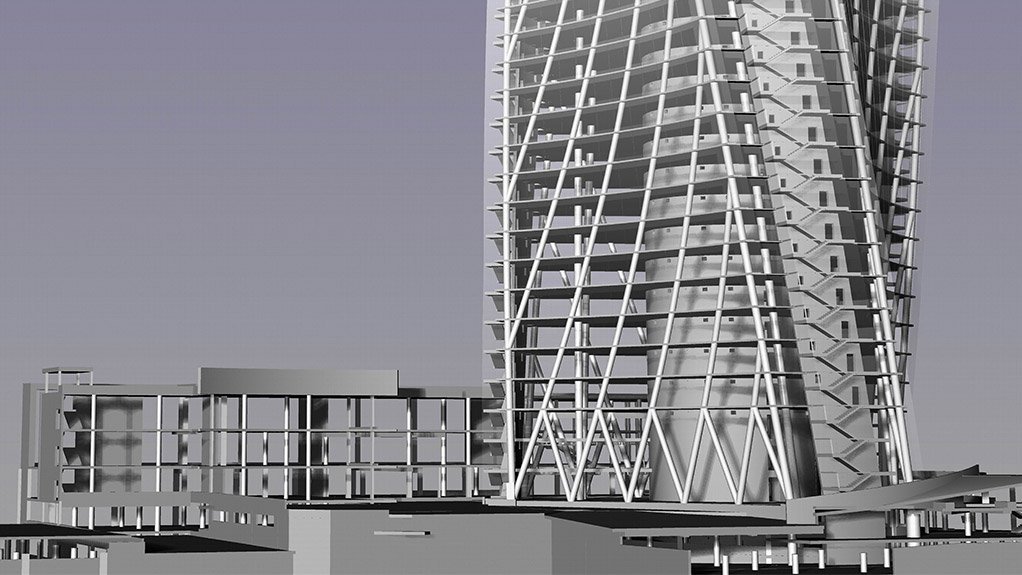A Twist Of Arup
This article has been supplied as a media statement and is not written by Creamer Media. It may be available only for a limited time on this website.
The horizon of Midrand, north of Johannesburg, is set to change forever with the construction of the new PwC Tower, which will be widely visible and a focal point in the up and coming Waterfall City development. It is set to become a structure of iconic proportion due to its distinctive twisted form designed by LYT Architecture for Attacq Waterfall Investment Company and their developer Atterbury, and realised through close collaboration with Arup - one of South Africa’s leading design engineering consultancies.
Parametric modelling
To achieve the building’s twist, each floor of the 28-storey office tower rotates 1.2 degrees relative to the floor below. This posed a variety of design challenges for both the structure and façade, many of which Arup was able to solve creatively and efficiently using parametric modelling.
“We needed to ensure our design solutions met the architect’s intent and that a creative concept could be successfully applied,” Richard Lawson, buildings associate at Arup says. “At Arup we are fortunate to be able to share cutting edge research and technology within our global network. It enables us to tap into the latest scientific knowledge and creative thought, which when combined with the utilisation of software, allows us to push the boundaries of design. Our advanced parametric modelling software and systems enables us to explore many options in our search to establish the optimal solution for complex building designs such as the PwC Tower project.”
Arup façade engineer Rudolf le Roux describes parametric modelling as ‘modelling a structure or object in an n-dimensional space, where certain chosen parameters of the structure are adjustable’. In other words it makes it possible to explore the impact of any of the input parameters on the design and cost of a structure.
Building design
“The biggest structural challenge was that the twist causes the gravity loads to naturally create a clockwise torsional load on the building,” explains Lawson. “The obvious solution to this would have been a very thick core wall, but because we were able to quickly asses a number of different structural geometries, we were able to optimise the solution. Our final scheme incorporated structural columns on the façade of the building that slope in a counter clockwise direction around the core, balancing the gravity loads on the corner columns and reducing the torsion on the core of the tower. This meant that the stresses on the core wall decreased by a factor of four; therefore we could use a 450mm thick wall which is not much thicker than a typical straight tower of that height would have needed.”
Le Roux continues, “We also utilised parametric modelling for the design of the façade for the PwC building. Various solutions were on the drawing board at the conceptual stage with factors such as glass utilisation, aesthetic integration with the structure and integration of blinds with a sloping, slanting façade. Building a concave, twisted façade out of straight aluminium profiles and flat glass was a challenge made possible through parametric modelling.
“What we really enjoyed was that we could sit down with the architect and make real-time adjustments to things like the column spacing and angles that they could see instantly in 3D. It makes collaboration easy, and results in far less exchange of correspondence back and forth,” explains le Roux.
Guy Steenkamp, Director of LYT Architecture agrees, “The team at Arup brings international experience to the project, although they are all local professionals. The kind of systems and thinking that they were able to apply to the design really made that building possible, so it’s as much their design as it is ours.”
Beyond the structure
Parametric modelling was even used in some more unusual aspects of the building’s design. Given that the PwC façade is concave and twisting, and knowing the history of high profile cases of problems caused by concentrated solar reflections from buildings - notably those at 20 Fenchurch Street in London (the “Walkie-Talkie”) - the Arup team knew that this was something that would need careful study for the tower.
“At the time of design no software existed for the purpose of calculating the intensities of solar reflections,” said le Roux. “Since the exact geometry of the façade had already been created in the parametric software, we used it to calculate and add up reflections from the façade. We could then test the effect of different proposed counter measures by including additional parameters such as glass reflectance and installation tolerances. With this knowledge, we were able to provide feasible and practical solutions to mitigate the impact of the solar reflections.”
Creating an elegant solution for the geometry made it easier to solve secondary problems like the cleaning and maintenance of the façade. Arup worked with the contractors to develop an integrated system where guide rails run along the mullions to guide a cleaning gondola over the height of the building. The same parametric model generated the geometry of the mullions.
All projects can benefit
Lawson adds, “Many factors went into the parametric modelling equation for the PwC Tower to come to the final optimised solution. Our use of parametric modelling software on a project of this scale is unique within South Africa, and our clients, as well as ourselves, are reaping benefits from the optimised holistic design on projects where we are collaborating.
“The beauty of taking a parametric design approach is both in time and cost efficiencies and a better integrated and well considered design, with all architectural and construction factors in sync.
“Not all projects are as technically challenging as the PwC Tower, but we believe less complex developments can also benefit from being set up in a parametric way. It allows designers to review the impact of many more design considerations within a given timeframe. We also often use parametric modelling for specific pieces of a project. For example it was used to resolve the buildability of the glass “pillow” façade on The Royal Portfolio’s The Silo luxury hotel at the V&A Waterfront in Cape Town.”
Integration into BIM
“A further beneficial aspect to parametric modelling is the way it feeds into other software, particularly our Building Information Modelling (BIM). Arup uses BIM as our default method for producing and managing design work. When used to its full potential, BIM improves collaboration between all stakeholders on a project – from designers to contractor to operator - throughout the project lifespan. We are excited about the advancements happening in the industry and look forward to a time when the all players in the industry have full BIM capability.
“These technologies enable us to take a fresh look at projects and the range of different solutions offered, backed by a wealth of knowledge that can address any challenge effectively,” concludes Lawson.
The PwC Tower will form the content of Le Roux’s paper delivered at The Sixth International Conference on Structural Engineering, Mechanics and Computation, (SEMC) in September.
Comments
Press Office
Announcements
What's On
Subscribe to improve your user experience...
Option 1 (equivalent of R125 a month):
Receive a weekly copy of Creamer Media's Engineering News & Mining Weekly magazine
(print copy for those in South Africa and e-magazine for those outside of South Africa)
Receive daily email newsletters
Access to full search results
Access archive of magazine back copies
Access to Projects in Progress
Access to ONE Research Report of your choice in PDF format
Option 2 (equivalent of R375 a month):
All benefits from Option 1
PLUS
Access to Creamer Media's Research Channel Africa for ALL Research Reports, in PDF format, on various industrial and mining sectors
including Electricity; Water; Energy Transition; Hydrogen; Roads, Rail and Ports; Coal; Gold; Platinum; Battery Metals; etc.
Already a subscriber?
Forgotten your password?
Receive weekly copy of Creamer Media's Engineering News & Mining Weekly magazine (print copy for those in South Africa and e-magazine for those outside of South Africa)
➕
Recieve daily email newsletters
➕
Access to full search results
➕
Access archive of magazine back copies
➕
Access to Projects in Progress
➕
Access to ONE Research Report of your choice in PDF format
RESEARCH CHANNEL AFRICA
R4500 (equivalent of R375 a month)
SUBSCRIBEAll benefits from Option 1
➕
Access to Creamer Media's Research Channel Africa for ALL Research Reports on various industrial and mining sectors, in PDF format, including on:
Electricity
➕
Water
➕
Energy Transition
➕
Hydrogen
➕
Roads, Rail and Ports
➕
Coal
➕
Gold
➕
Platinum
➕
Battery Metals
➕
etc.
Receive all benefits from Option 1 or Option 2 delivered to numerous people at your company
➕
Multiple User names and Passwords for simultaneous log-ins
➕
Intranet integration access to all in your organisation





















